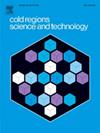Effects of forest fire on successional trajectory of understory vegetation in boreal permafrost region in Northeast China
IF 3.8
2区 工程技术
Q1 ENGINEERING, CIVIL
引用次数: 0
Abstract
In boreal permafrost regions, forests are among the primary ecotypes, where fire severity, extent and frequency have been rising due to a warming climate. Following a fire, the composition (species types and diversity), structure (arrangement and layering of trees and undergrowth), and successional trajectory (changes in the ecosystem over time) of forest vegetation are modified. These changes have significant impacts on ecosystem carbon balance, ecosystem services, and forest management, influencing carbon release and storage, biodiversity, hydrological cycles, as well as fire prevention measures and risk assessment. However, at the southern edge of the boreal forest, where permafrost ecosystems are particularly vulnerable to climate change and wildfire disturbances, few studies have focused on post-fire understory vegetation renewal and succession. In this study, we selected six burned areas in Northeast China, including four larch forests and two shrub wetlands, to examine vegetation succession pathways under varying fire severities from 4 to 32 years after wildfires. The results showed that in larch forests, herbaceous vegetation, particularly graminoids, benefited from fire disturbances in the early post-fire period, showing significant increases in coverage, biomass, height, and species diversity. In the mid- post-fire period (four to ten years after the fire), shrubs, especially tall shrubs, began to benefit from forest fires, showing significant increases in cover, biomass and height. Tall shrub species increased during the early post-fire period (first four years), then declined, gradually recovering in the middle and late post-fire period (10 to 32 years). In larch forests, fire severity and post-fire increase in soil temperature and moisture contents constrained shrub growth while promoting herbaceous vegetation. Similarly, in shrub wetlands, shrub coverage and biomass remained higher at burned sites than at unburned ones, while the opposite trend was observed for herbaceous vegetation. In contrast to larch forest, shrub coverage significantly increased in shrub wetlands following a fire. During the period of 17 to 32 years after the fire, the height and species diversity of herbs and shrubs were lower at the burned sites compared to unburned sites, leading to the transformation of herb-dominated wetlands into shrub-dominated ones. Fire severity and permafrost degradation significantly inhibited herb growth while promoting shrub growth in shrub wetlands. These fire-induced effects intensified with rising fire severity, and the legacy effects of forest fires on herbs and shrubs persisted for up to 32 years after the event. Additionally, forest fires increased the species diversity of flowering plants. Therefore, this study provides valuable data to support the restoration and management of vegetation following forest fires in boreal forest regions.
求助全文
约1分钟内获得全文
求助全文
来源期刊

Cold Regions Science and Technology
工程技术-地球科学综合
CiteScore
7.40
自引率
12.20%
发文量
209
审稿时长
4.9 months
期刊介绍:
Cold Regions Science and Technology is an international journal dealing with the science and technical problems of cold environments in both the polar regions and more temperate locations. It includes fundamental aspects of cryospheric sciences which have applications for cold regions problems as well as engineering topics which relate to the cryosphere.
Emphasis is given to applied science with broad coverage of the physical and mechanical aspects of ice (including glaciers and sea ice), snow and snow avalanches, ice-water systems, ice-bonded soils and permafrost.
Relevant aspects of Earth science, materials science, offshore and river ice engineering are also of primary interest. These include icing of ships and structures as well as trafficability in cold environments. Technological advances for cold regions in research, development, and engineering practice are relevant to the journal. Theoretical papers must include a detailed discussion of the potential application of the theory to address cold regions problems. The journal serves a wide range of specialists, providing a medium for interdisciplinary communication and a convenient source of reference.
 求助内容:
求助内容: 应助结果提醒方式:
应助结果提醒方式:


